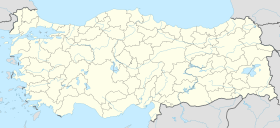Hamaxitus
| Ἁμαξιτός | |
| Location | Gülpınar, Çanakkale Province, Turkey |
|---|---|
| Region | Troad |
| Coordinates | 39°32′18″N 26°5′35″E / 39.53833°N 26.09306°ECoordinates: 39°32′18″N 26°5′35″E / 39.53833°N 26.09306°E |
| Type | Settlement |
| History | |
| Builder | Colonists from Mytilene |
| Founded | Possibly during the 8th or 7th centuries BC |
| Abandoned | Possibly after the 7th or 8th century AD |
Hamaxitus (Ancient Greek: Ἁμαξιτός Hamaxitos) was an ancient Greek city in the south-west of the Troad region of Anatolia which was considered to mark the boundary between the Troad and Aeolis. Its surrounding territory was known in Greek as Ἁμαξιτία (Hamaxitia), and included the temple of Apollo Smintheus, the salt pans at Tragasai, and the Satnioeis river (modern Tuzla Çay). It has been located on a rise called Beşiktepe near the village of Gülpınar (previously Külahlı) in the Ayvacık district of Çanakkale Province, Turkey.
Hamaxitus first appears in the Athenian tribute lists in the 425/4 BC as hαμαχσιτός [hamakʰsiˈtos]. However, this spelling reflects the influence of Attic Greek and is not a reliable guide to how Hamaxitans would have spelt or pronounced the name of their city. Hamaxitus was located in an Aeolic-speaking area: Aeolic, like other so-called East Greek dialects, was psilotic and so, unlike Attic Greek, had lost the phoneme /h/. This retained /h/ is seen in the Attic spelling of Hamaxitus with an eta, which in Attic unlike other dialects represented [h] rather than [ɛː]. Likewise, the use of the digraph -χσ- (/khs/) for -ξ- (/x/) reflects Attic, not Aeolic usage. The grapheme ξ (xi) originally represented /ks/ (κσ); it was a peculiarity of Attic (consistent with not being psilotic and therefore retaining audibly aspirated consonants) that /ks/ was pronounced /khs/ and so represented by the grapheme χσ, as here in hαμαχσιτός. All other literary and epigraphic sources refer to Ἁμαξιτός and on the city's own coinage from the 4th century BC read ΑΜΑΞΙ (AMAXI, i.e. Ἁμαξι(τός), Hamaxi(tos)). The city's name derives from ἅμαξα (hamaxa) meaning 'wagon', hence the adjective ἁμαξιτός (hamaxitos), 'traversed by wagons', 'carriage-road', 'high-road'. Remains of an ancient road have been identified leading away up the coast from the sheltered bay immediately below the rise on which the Classical city was located at Beşiktepe, indicating the name's origin.
...
Wikipedia

